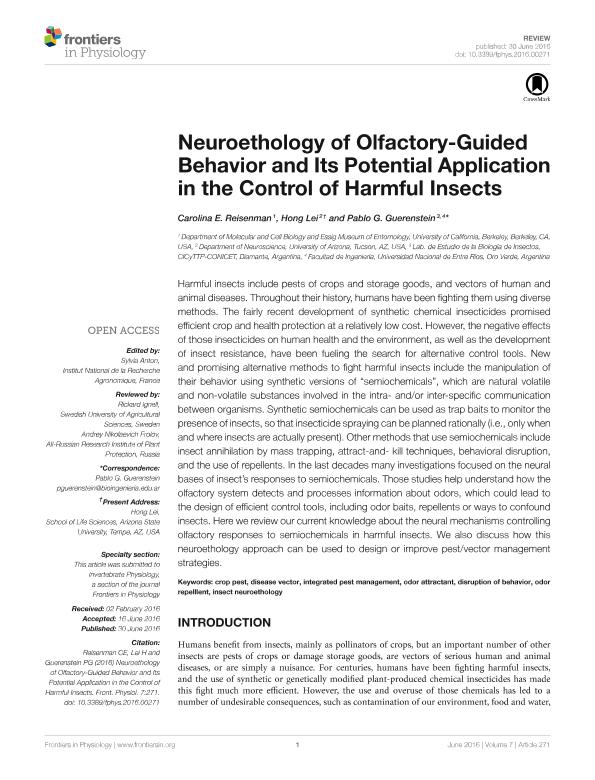Mostrar el registro sencillo del ítem
dc.contributor.author
Reisenman, Carolina Esther

dc.contributor.author
Lei, Hong
dc.contributor.author
Guerenstein, Pablo Gustavo

dc.date.available
2019-07-22T19:16:36Z
dc.date.issued
2016-06
dc.identifier.citation
Reisenman, Carolina Esther; Lei, Hong; Guerenstein, Pablo Gustavo; Neuroethology of olfactory-guided behavior and its potential application in the control of harmful insects; Frontiers Research Foundation; Frontiers in Physiology; 7; 271; 6-2016; 1-21
dc.identifier.issn
1664-042X
dc.identifier.uri
http://hdl.handle.net/11336/79974
dc.description.abstract
Harmful insects include pests of crops and storage goods, and vectors of human and animal diseases. Throughout their history, humans have been fighting them using diverse methods. The fairly recent development of synthetic chemical insecticides promised efficient crop and health protection at a relatively low cost. However, the negative effects of those insecticides on human health and the environment, as well as the development of insect resistance, have been fueling the search for alternative control tools. New and promising alternative methods to fight harmful insects include the manipulation of their behavior using synthetic versions of "semiochemicals", which are natural volatile and non-volatile substances involved in the intra-and/or inter-specific communication between organisms. Synthetic semiochemicals can be used as trap baits to monitor the presence of insects, so that insecticide spraying can be planned rationally (i.e., only when and where insects are actually present). Other methods that use semiochemicals include insect annihilation by mass trapping, attract-and-kill techniques, behavioral disruption, and the use of repellents. In the last decades many investigations focused on the neural bases of insect's responses to semiochemicals. Those studies help understand how the olfactory system detects and processes information about odors, which could lead to the design of efficient control tools, including odor baits, repellents or ways to confound insects. Here we review our current knowledge about the neural mechanisms controlling olfactory responses to semiochemicals in harmful insects. We also discuss how this neuroethology approach can be used to design or improve pest/vector management strategies.
dc.format
application/pdf
dc.language.iso
eng
dc.publisher
Frontiers Research Foundation

dc.rights
info:eu-repo/semantics/openAccess
dc.rights.uri
https://creativecommons.org/licenses/by/2.5/ar/
dc.subject
Crop Pest
dc.subject
Disease Vector
dc.subject
Disruption of Behavior
dc.subject
Insect Neuroethology
dc.subject
Integrated Pest Management
dc.subject
Odor Attractant
dc.subject
Odor Repelllent
dc.subject.classification
Zoología, Ornitología, Entomología, Etología

dc.subject.classification
Ciencias Biológicas

dc.subject.classification
CIENCIAS NATURALES Y EXACTAS

dc.title
Neuroethology of olfactory-guided behavior and its potential application in the control of harmful insects
dc.type
info:eu-repo/semantics/article
dc.type
info:ar-repo/semantics/artículo
dc.type
info:eu-repo/semantics/publishedVersion
dc.date.updated
2019-07-22T13:15:55Z
dc.journal.volume
7
dc.journal.number
271
dc.journal.pagination
1-21
dc.journal.pais
Suiza

dc.journal.ciudad
Lausanne
dc.description.fil
Fil: Reisenman, Carolina Esther. University of California at Berkeley; Estados Unidos
dc.description.fil
Fil: Lei, Hong. University of Arizona; Estados Unidos
dc.description.fil
Fil: Guerenstein, Pablo Gustavo. Provincia de Entre Ríos. Centro de Investigaciones Científicas y Transferencia de Tecnología a la Producción. Universidad Autónoma de Entre Ríos. Centro de Investigaciones Científicas y Transferencia de Tecnología a la Producción. Consejo Nacional de Investigaciones Científicas y Técnicas. Centro Científico Tecnológico Conicet - Santa Fe. Centro de Investigaciones Científicas y Transferencia de Tecnología a la Producción; Argentina. Universidad Nacional de Entre Ríos. Facultad de Ingeniería; Argentina
dc.journal.title
Frontiers in Physiology
dc.relation.alternativeid
info:eu-repo/semantics/altIdentifier/doi/http://dx.doi.org/10.3389/fphys.2016.00271
dc.relation.alternativeid
info:eu-repo/semantics/altIdentifier/url/https://www.frontiersin.org/articles/10.3389/fphys.2016.00271
Archivos asociados
